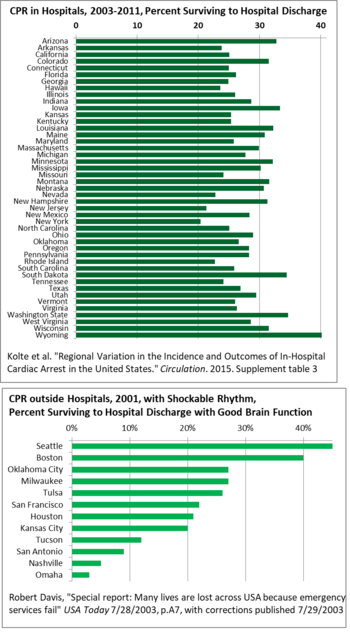The Life Support Professionals Statements
Table of ContentsAn Unbiased View of Life Support ProfessionalsGetting My Life Support Professionals To WorkSome Ideas on Life Support Professionals You Need To KnowThe Main Principles Of Life Support Professionals The 6-Minute Rule for Life Support Professionals
Verify the defibrillator is readied to the appropriate dose of electrical energy - 200 Joules for adults, as well as press the cost switch. Wait up until the defibrillator is totally charged. The piercing billing tone will get louder when the defibrillator is all set. Clear all personnel away and make certain that no person remains in physical call with the patient.The piercing tone will certainly stop, and also the individual will "jump", indicating that electrical power was delivered efficiently. Resume MOUTH-TO-MOUTH RESUSCITATION promptly after providing the shock, as well as continue for 2 minutes prior to stopping briefly once more to reassess the rhythm. Notice that there has been no mention of ventilation, vascular accessibility, or medications approximately this factor.
In the first few mins of resuscitation, the concerns are quick recognition of heart attack, initiation of high-grade breast compressions, and efficiency of defibrillation when indicated. Quality CPR is definitely vital to heart arrest survival, as well as must be refined by all doctor. Ideally, the initial compression ought to be provided in the initial 30 seconds of the apprehension.
You have just watched a Jo, VE video outlining the CPR as well as fast defibrillation treatment. You ought to currently understand the crucial actions of this technique and additionally the rationale behind these actions. As constantly, many thanks for viewing!.
Facts About Life Support Professionals Revealed
When seconds count, HANDS-ONLY CPR can help save a life. Complying with a cardiac event, the body ends up being robbed of oxygen, placing heart and brain feature at risk. Life Support Professionals. The HANDS-ONLY MOUTH-TO-MOUTH RESUSCITATION strategy help oxygen delivery as well as sustains heart and also brain function until first responders show up to administer much more advanced clinical steps.
Provide breast compressions. Area hands in the center of the breast as well as start compressions, hard as well as fast, at a price of 100 beats per minute.
If you're on your own as well as there are people around, you can shout out for help, obtain a person's interest. Have them call 9-1-1 and also ideally get an AED. If you're on your own and you have a mobile phone, you can call 9-1-1, put it on audio speaker, begin talking with the dispatcher while you most likely to deal with the individual.
You're going to need to go call 9-1-1 as well as hopefully grab an AED. As quickly as you can, return to your sufferer. If there are 2 rescuers reacting, 2 people there, one of them is mosting likely to go call 9-1-1, hopefully obtain an AED. The 2nd rescuer is quickly mosting visit the site likely to most likely to deal with the client.
Life Support Professionals Things To Know Before You Get This
Unless you feel a solid, apparent pulse, start upper body compressions. That's not a pulse, start chest compressions. Where we can get stumbled up on this is if the person presents with agonal breaths.
Anything besides sustained, balanced breathing with the upper body coming up as well as down is not efficient breathing. This pulse check as well as this look for breathing combined ought to take no greater than 10 seconds. Really feel for at the very least 5 seconds, consider the chest for at least 5 secs, however no greater than 10 secs, in genuine life and you're probably going to see it on an examination in your instant future.
You want the heel of your hand on the client's midline, center of the breast, simply concerning the xiphoid process. If your hand is as well high up on the breast, you're not going to get adequate compression deepness.

4 Easy Facts About Life Support Professionals Described
If you're at an angle at all, rather than the breast fluctuating such as this, it's mosting likely to start relocating side to side and also you're not going to get sufficient compression deepness. See to it you're positioned directly over the person, directly down at the very least 2 inches, not to go beyond 2.
You've started chest compressions, currently let's discuss the ventilations. If you're supplying mouth-to-mask air flows, you're mosting likely to place on your own sideways of the individual and location Read More Here the mask directly over the target's mouth as well as nose. You're going to put one hand over the bridge of the nose. With the other hand, take the thumb, cover the base of the mask.
Then you can give your two breaths. When you're offering a breath, administering your breath, it needs to take you regarding 1 second to put that breath in. That's the I-time (inspiratory time). How much time it takes for you to actually place that breath in should be concerning 1 second. Allow all the air come out.
Provide one more breath webpage over 1 second and let that breath come all the way out. Our ratio of compressions to air flows without an advanced air passage is 30:2 (30 chest compressions, 2 breaths of air; 30 chest compressions, 2 breaths of air). Every 2 mins, or about 5 cycles, we're mosting likely to turn out.
Little Known Facts About Life Support Professionals.
